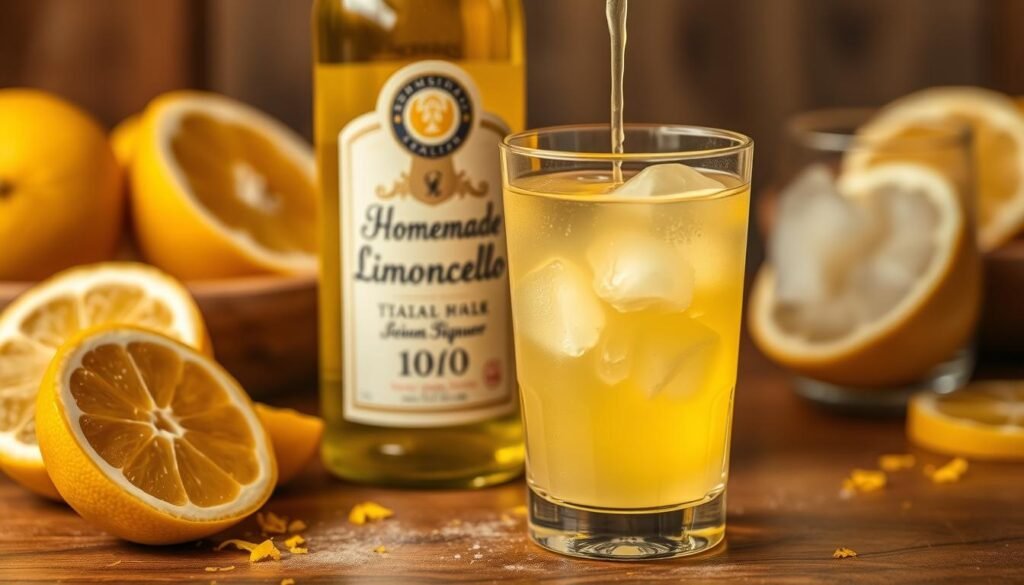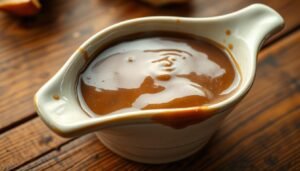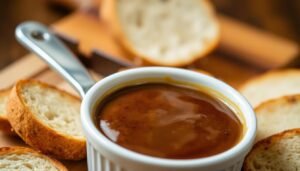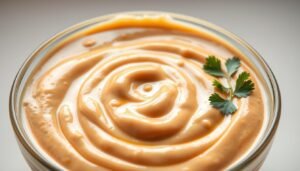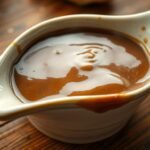Standing on the Amalfi Coast, I discovered limoncello, a citrusy Italian liqueur. Italy makes over 20 million liters of it yearly. This shows its love worldwide.
Limoncello is more than a drink; it’s a sign of Italian welcome. Making homemade limoncello is easy. You need fresh lemons, alcohol, and sugar. It’s perfect for hot nights or after meals.
Key Takeaways
- Understanding what limoncello is and its cultural significance.
- Learning the basic ingredients needed for a limoncello recipe.
- Discovering the simplicity of making homemade limoncello.
- The versatility of limoncello as a drink.
- Tips for serving limoncello.
What is Limoncello and Its Origins?
Limoncello is a lemon-flavored liqueur from Italy, famous worldwide. It comes from the Amalfi Coast, where lemons grow in abundance. This drink is a big part of Italian culture and food.
The History of Limoncello
Limoncello’s story began in the early 1900s. Its exact start is a mystery. But, it’s thought to have come from the Amalfi Coast, where lemons have been grown for ages. Making limoncello was once a family tradition, with recipes shared for generations.
Cultural Significance in Italy
In Italy, limoncello is more than a drink. It’s a sign of welcome and culture. It’s served cold after meals to help with digestion. Limoncello is a key part of Italian food traditions, enjoyed at social events and celebrations.
Limoncello’s fame has led to new flavors and recipes. But, the classic recipe is still loved by many. Here’s a look at traditional limoncello and its modern twists:
| Characteristics | Traditional Limoncello | Modern Variations |
|---|---|---|
| Flavor Profile | Strong lemon flavor | Varied (e.g., blood orange, raspberry) |
| Production Method | Infusion of lemon zest in alcohol | Infusion with various fruits or herbs |
| Serving Tradition | Chilled, as a digestif | Used in cocktails or as a dessert topping |
Ingredients Needed for Your Limoncello
To make a tasty limoncello, you need a few key ingredients. The quality of these ingredients affects the taste and feel of your homemade limoncello.
Choosing the Right Lemons
The first and most important ingredient is lemons. You can’t just use any lemons. You need ones that are full of oil and have thick skin. Sorrento lemons or Amalfi Coast lemons are the best because of their high quality and taste.
When picking lemons, look for ones that are firm and bright yellow. Stay away from lemons with soft spots or blemishes. They won’t taste as good.
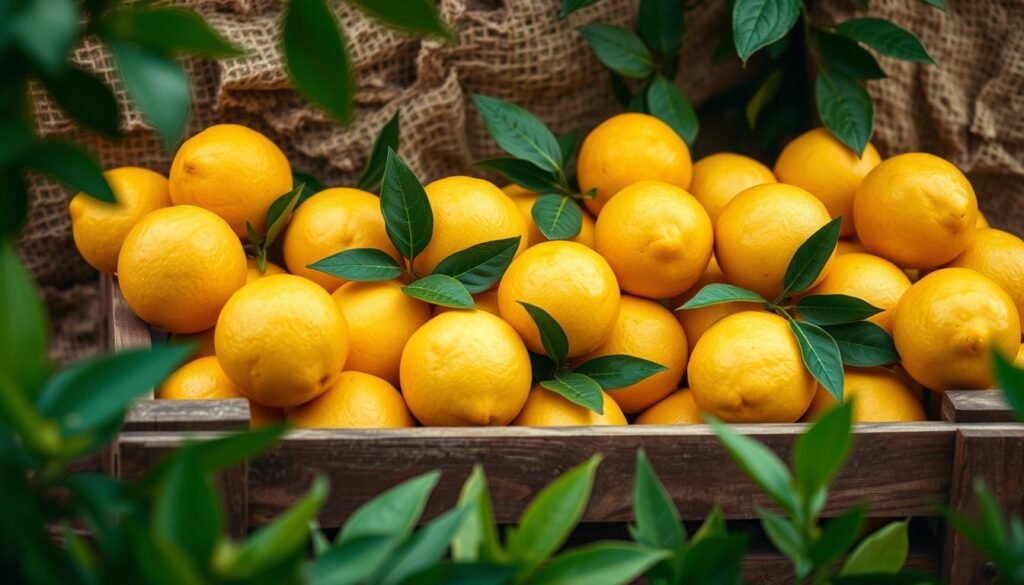
Essential Ingredients List
Here’s what you need to make limoncello:
| Ingredient | Quantity | Purpose |
|---|---|---|
| Lemons | 4-6 | For the lemon zest and flavor |
| Everclear or High-Proof Vodka | 1 liter | To infuse with lemon flavor |
| Simple Syrup (Sugar and Water) | 2 cups sugar, 2 cups water | To sweeten the limoncello |
As
“The best limoncello is made with love and the finest ingredients.”
, many limoncello fans agree. The quality of your ingredients is crucial.
By using the right ingredients and choosing the best lemons, you’ll make a delicious and true limoncello.
Step-by-Step Guide to Making Limoncello
I’ll show you how to make limoncello, from starting with lemons to the final mix. Making it at home is fun and rewarding. It only needs a few ingredients and patience.
Preparing the Lemons
The first step is to prepare the lemons. You need high-quality, organic lemons with thick skins. Choose lemons that are heavy for their size and have a vibrant yellow color. Wash them well, then dry with a clean towel.
Peel the lemons carefully with a vegetable peeler or sharp knife. Make sure to avoid the white pith, as it’s bitter. The peels will infuse the alcohol with lemon flavor.
Infusing the Alcohol
Put the lemon peels in a large glass jar. Cover them with high-proof alcohol, like vodka or Everclear. The alcohol will extract the oils from the lemon peels, creating the base flavor of your limoncello. Seal the jar and keep it in a cool, dark place for at least 10 days.
Shake the jar every few days to help the infusion. The longer it infuses, the stronger the flavor will be.
Mixing the Simple Syrup
After the infusion, mix the simple syrup. Combine equal parts of water and granulated sugar in a saucepan. Heat it over medium heat, stirring until the sugar dissolves. This simple syrup will balance out the acidity and bitterness of the lemon.
Let the simple syrup cool before mixing it with the infused alcohol. Start with a 1:1 ratio of simple syrup to alcohol, adjusting to taste.
| Ingredient | Quantity | Purpose |
|---|---|---|
| Lemons | 4-6 | Source of flavor and aroma |
| Alcohol (vodka or Everclear) | 1 liter | Base for infusion |
| Granulated Sugar | 1 cup | To balance flavor |
| Water | 1 cup | To dilute the syrup |
Tips for Perfecting Your Limoncello
Making limoncello that’s truly exceptional requires a bit of finesse. As you refine your recipe, you’ll find that the key to a great limoncello lies in the balance of its flavors.
Adjusting Sweetness Levels
The sweetness level in limoncello is a matter of personal preference. Some like it very sweet, while others prefer it more tart. To adjust the sweetness, you can vary the amount of simple syrup you add to the infused alcohol. Start with a smaller amount and taste as you go, adding more syrup until you reach your desired level of sweetness.
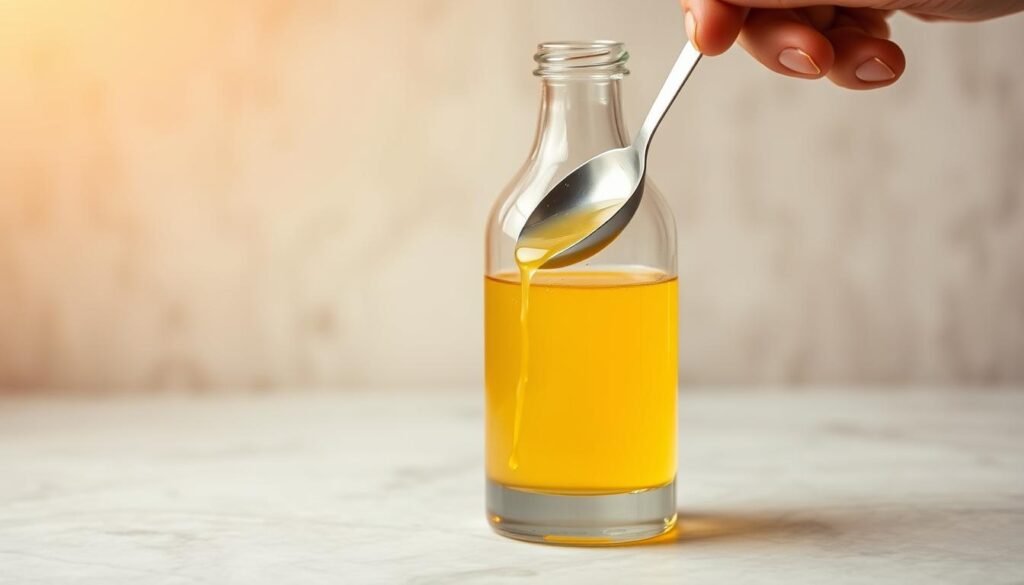
Infusion Time Best Practices
The infusion time is critical for achieving the perfect flavor. Infusing the alcohol with lemon zest for the right amount of time ensures that your limoncello has a robust and refreshing citrus flavor. Generally, a longer infusion time results in a stronger flavor, but be careful not to overdo it, as this can lead to bitterness.
- For a lighter flavor, infuse for 7-10 days.
- For a stronger flavor, infuse for 14-21 days.
Always store the infusion in a cool, dark place and shake the container every few days to help the infusion process.
Bottling and Storing Your Limoncello
Proper bottling and storage are key to keeping your homemade limoncello fresh. The right bottle can greatly affect how long your limoncello stays good.
Choosing the Right Bottles
Choosing the right bottles for your limoncello is important. Go for dark glass bottles to keep it away from light. This helps prevent it from spoiling. Use bottles with tight-fitting stoppers or corks to keep air out.
| Bottle Type | Light Protection | Seal Quality |
|---|---|---|
| Clear Glass | No | Variable |
| Dark Glass | Yes | Variable |
| Dark Glass with Stopper | Yes | Excellent |
Storage Recommendations
After bottling, store your limoncello in a cool, dark spot. A refrigerator or cool cellar is best. Keep the temperature steady, between 60°F to 70°F (15°C to 21°C).
- Keep the limoncello away from direct sunlight.
- Store the bottles upright to avoid contact with the cork or stopper.
- Avoid storing limoncello near strong-smelling foods, as it can absorb odors.
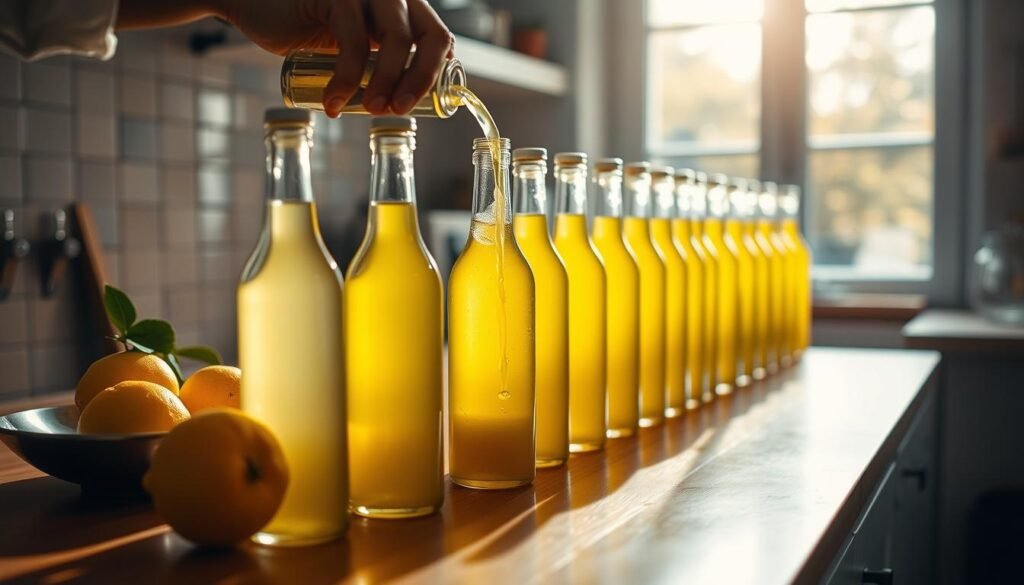
Using Homemade Limoncello in Cocktails
Homemade limoncello is more than just a digestif. It’s a key ingredient for making tasty cocktails. Its bright citrus taste can make any drink better, from simple spritzers to fancy martinis.
Having homemade limoncello lets you try out different cocktail recipes. You can tweak the sweetness and flavor to make each drink special.
Classic Limoncello Spritz
A limoncello spritz is a cool and simple cocktail for hot days. Here’s what you need:
- 2 oz limoncello
- 2 oz Prosecco
- 1 oz soda water
- Slice of lemon for garnish
Mix limoncello and Prosecco in a glass with ice. Then, add soda water. Top it off with a lemon slice garnish and serve right away.
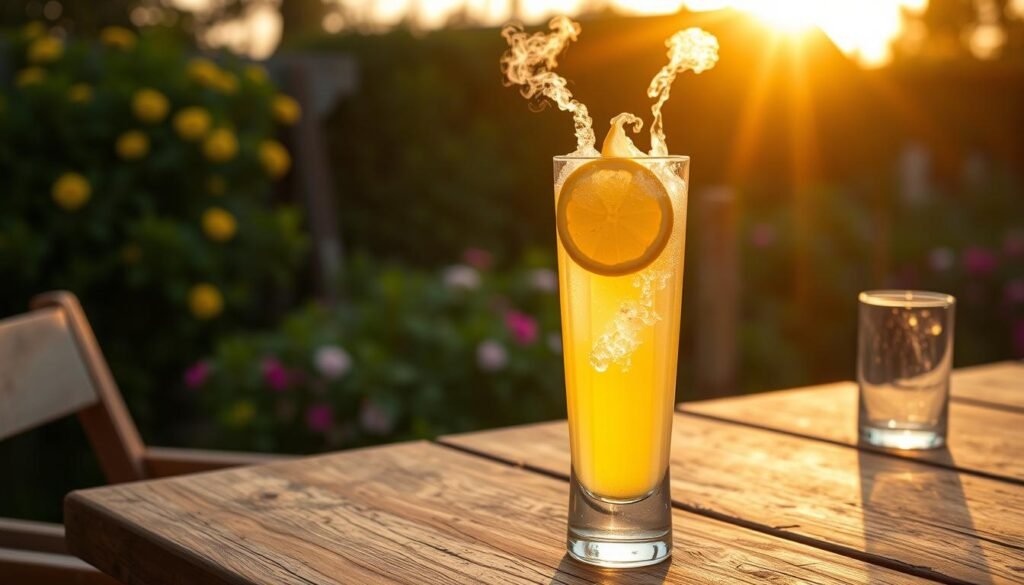
Limoncello Martini Inspiration
For a fancy cocktail, try a limoncello martini. Here’s how to make it:
- 2 oz limoncello
- 1 oz vodka
- 1/2 oz simple syrup
- Lemon twist for garnish
Shake all ingredients with ice, then pour into a chilled martini glass. Finish with a lemon twist garnish for a fancy touch.
Don’t be afraid to mix things up. Try different vodka flavors or add some citrus juice to make your own limoncello martini.
Serving Suggestions for Limoncello
To fully enjoy limoncello, serving it right is key. It’s not just about pouring it into a glass. It’s about making an experience that matches its unique taste and smell.
Best Temperature to Serve
Limoncello tastes best when it’s chilled. The perfect serving temperature is between 32°F and 40°F (0°C and 4°C). To chill it, put it in the freezer for a few hours before serving. But, don’t let it freeze solid, as it can change the taste and feel.
Pairing with Dessert
Limoncello goes well with many desserts, like those with citrus or creamy parts. Here are some great pairings:
- Lemon Bars: The citrusy zing of limoncello pairs well with lemon bars’ tartness.
- Tiramisu: The creamy texture and coffee of tiramisu match limoncello’s bright citrus notes.
- Panna Cotta: A lightly sweetened panna cotta gets better with chilled limoncello served alongside.
When serving limoncello with dessert, think about the flavors and textures. This will help create a balanced and enjoyable meal.
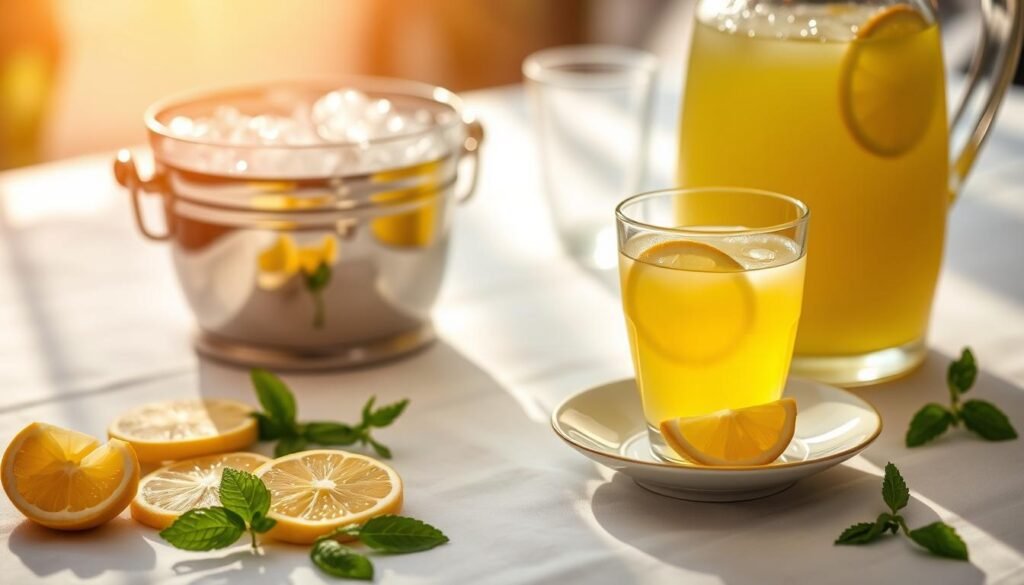
Don’t just stick to these ideas. Try different desserts with limoncello to find your favorite way to enjoy it. Limoncello’s versatility makes it a great match for many sweet treats.
Troubleshooting Common Limoncello Issues
When you start making your own limoncello, you might hit a few bumps. The process is simple, but some problems can mess up your drink’s quality and taste.
Murky or Cloudy Limoncello
One big problem is when your limoncello looks murky or cloudy. This can happen if you don’t filter it right or use bad ingredients. To fix this, filter your limoncello through a fine-mesh sieve or cheesecloth before you bottle it. Also, using top-notch lemons and keeping your tools clean can help avoid cloudiness.
If your limoncello is still cloudy after filtering, it might be because you infused the lemon peels for too long. This can make the drink cloudy. Try shortening the infusion time to solve this problem.
Too Sweet or Not Sweet Enough
Finding the right sweetness level is another challenge. Limoncello should be both sweet and sour, but getting it just right can be hard. If it’s too sweet, cut down the simple syrup in your recipe. If it’s not sweet enough, add a bit more.
It’s key to taste your limoncello as you make it and adjust the sweetness. Remember, the sweetness will seem less intense once it’s chilled.
Tips for Adjusting Sweetness:
- Taste your limoncello before finalizing the recipe.
- Adjust the simple syrup according to your taste preferences.
- Keep in mind that chilling the limoncello can affect its perceived sweetness.
By tackling these common problems, you can improve your limoncello recipe. This way, you’ll make a top-notch Italian liqueur that you’ll be happy to share with others.
Popular Variations of Limoncello
Limoncello isn’t just one recipe. You can try new flavors and ingredients to make unique styles. This way, you can find the perfect limoncello for your taste.
Flavored Limoncello Options
Want to make your limoncello special? Try adding new flavors. Here are some ideas:
- Ginger Limoncello: Spice it up with fresh ginger.
- Basil Limoncello: Add a herbaceous twist with basil leaves.
- Raspberry Limoncello: Mix in raspberries for a fruity twist.
These flavored limoncellos are great on their own or in cocktails. For example, ginger limoncello is perfect in a Moscow Mule. Basil limoncello is great in a summer spritz.
Unique Twist Ideas for Your Recipe
Want to make your limoncello even more special? Try these ideas:
- Use different citrus fruits like oranges or grapefruits for a unique taste.
- Add a bit of spice with cinnamon or nutmeg for warmth.
- Try flavored vodka or grain alcohol for new flavors.
By trying these variations, you can make a limoncello that’s just right for you. It will surely impress your friends and family.
Sharing Your Limoncello Creation
Now that you’ve mastered the art of making limoncello, it’s time to share it with others. Whether you’re hosting a dinner party or looking for a unique gift, your homemade limoncello is sure to impress.
Limoncello Tasting Event
Consider hosting a limoncello tasting event to showcase your creation. Invite friends and family to sample your limoncello alongside other Italian delights. This could include a KFC coleslaw recipe-inspired side dish. It will give your guests a chance to experience the full flavor profile of your limoncello.
Gifting Your Limoncello
Gifting homemade limoncello is a thoughtful way to share your creation with loved ones. Simply bottle your limoncello in decorative bottles. Add a personal touch with a handwritten label or gift tag. When sharing limoncello, be sure to include serving suggestions and storage tips to ensure your gift is enjoyed to the fullest.
By sharing your limoncello, you’ll be spreading the joy of this Italian delight. You’ll create new memories with friends and family. So go ahead, share your limoncello, and enjoy the smiles it brings to those around you.

